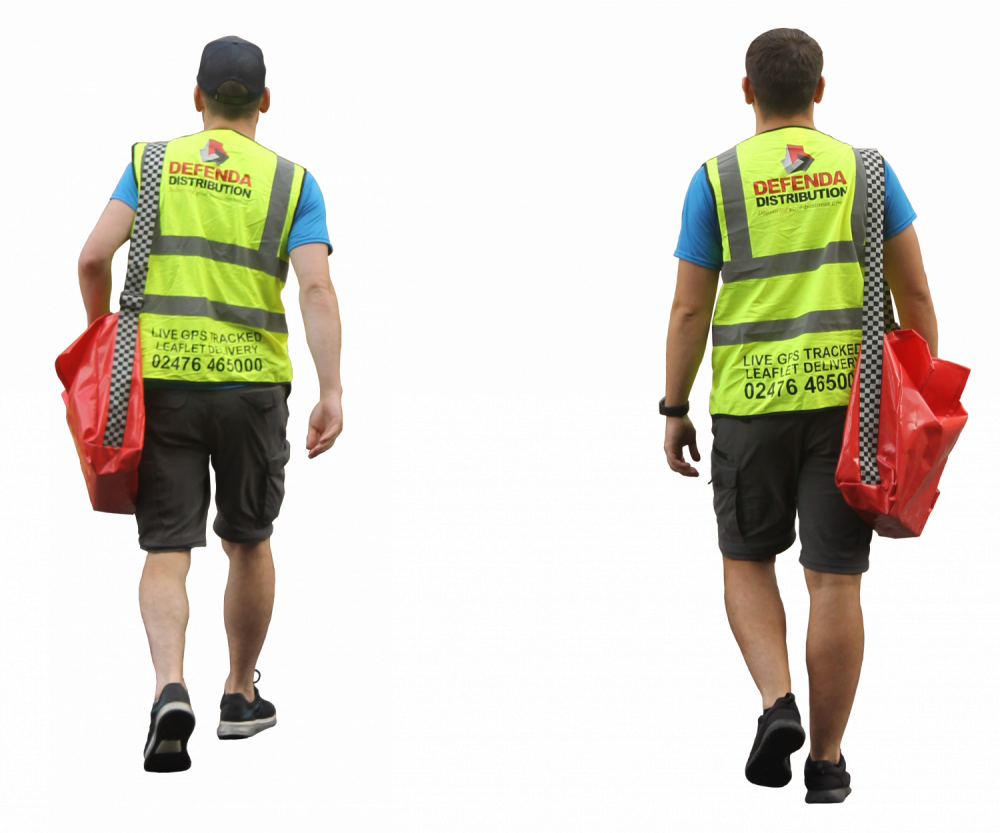Why Leafleting Is Essential for UK Building & Planning Companies: Proven, Trackable Resident Notification
Leafleting is one of the simplest tools available to builders, developers and planning consultants – but for construction and planning projects in the UK, it’s also one of the most powerful.
Whether you’re notifying neighbours about a loft conversion, a new housing development or a major infrastructure scheme, a well–planned leaflet drop can help you meet regulatory duties, avoid disputes and build goodwill with the local community. And when you work with a specialist distributor such as Defenda Leaflet Distribution, you also gain the ability to track every distributor and prove exactly which addresses have received a leaflet – a huge advantage when you need an audit trail.
Below we’ll look at why leafleting is such a good fit for building and planning companies, and how Defenda’s GPS–tracked, fully evidenced service supports public consultation and statutory notices across the UK.
1. Why notifying residents really matters
Building work is disruptive, even when it’s well–managed. Noise, dust, parking pressures and temporary changes to access all affect people’s daily lives. Many local authorities now stress the importance of clear communication before and during works, not just as a courtesy but as good practice. For example, the Royal Borough of Kensington and Chelsea explicitly advises developers to engage with residents well in advance and to maintain that communication while works continue. rbkc.gov.uk
In addition, there are specific legal and procedural reasons to notify people:
-
Planning applications & neighbour consultations: Local Planning Authorities (LPAs) typically send neighbour consultation letters so nearby residents can comment on a proposal.
-
Party wall works: Under the Party Wall etc. Act, you must give formal written notice to affected neighbours between two months and one year before certain types of work begin.
-
Local codes of practice: Many councils have neighbour notification policies and often choose letters over simple site notices because they are more direct and reliable.
Leaflets fit perfectly into this landscape. They are, in effect, well–designed letters that can explain the project, address concerns and direct people to more information – while also providing you with proof that you have done your part to inform them.
2. Why leafleting beats “hoping people see the notice”
Developers have several channels available – site notices, local press adverts, email, social media – but leafleting has a number of distinct advantages for planning communication.
2.1 Guaranteed presence in the home
A leaflet is delivered directly to the letterbox. Unlike a lamppost notice or a single sign on site, it doesn’t rely on people walking past at the right time or noticing a small board when they’re busy or driving. Door–to–door delivery dramatically increases the chance that every affected household actually receives the information.
2.2 High readability and clarity
A well–designed leaflet lets you:
-
Use plain language and diagrams to explain the project
-
Show site plans, phasing and timelines
-
Highlight noisy or disruptive stages in advance
-
Provide clear contact details for complaints or questions
-
Direct residents to planning portals or consultation websites
This level of clarity is much harder to achieve with a small statutory notice or a brief press ad.
2.3 Precise geographic targeting
For planning and construction, you often only need to reach:
-
Properties within a set radius of the site
-
Homes along a haul route
-
Businesses affected by road closures or deliveries
Leaflet campaigns can be shaped to very specific catchments around the scheme. Professional distributors use area mapping to define bespoke zones so you aren’t paying to contact people who are unaffected – or missing those who are.
3. Leafleting and UK planning / consultation requirements
Leafleting dovetails neatly with existing UK planning processes and good–practice frameworks.
3.1 Supporting LPA requirements
Some LPAs choose between using site notices or sending letters to adjoining owners/occupiers. In practice, many councils prefer letters where possible because they provide a clear record of who has been notified and when.
For developers, a leaflet delivered door–to–door by a professional distributor effectively functions as a consultation letter with better design and clearer messaging. When backed by GPS tracking and delivery reports, it can provide strong evidence that you have:
-
Reached the addresses you said you would
-
Informed residents of the nature and timing of the works
-
Offered a route for feedback or objections
This is particularly useful when planning conditions or agreements require you to demonstrate public engagement as part of the approval or discharge process.
3.2 Neighbourhood introduction and considerate construction
The Considerate Constructors Scheme, for example, encourages sites to send a neighbourhood introduction letter to all potentially affected neighbours, explaining when works will take place and how disruption will be managed.
Leaflets are a natural way to deliver these introduction letters at scale, and to repeat communication at key milestones:
-
Start of enabling or demolition works
-
Changes to working hours
-
Road closures, diversions or crane operations
-
Particularly noisy operations such as piling
A professional leaflet distribution programme helps you embed considerate behaviour into day–to–day site management.
4. Why tracking and proof of delivery are crucial
For planning and construction, being able to prove that you notified people can be as important as notifying them in the first place.
There are many situations where an audit trail is invaluable:
-
A resident claims they were never told about upcoming works.
-
An objector challenges the adequacy of consultation.
-
A planning condition requires proof that certain addresses were notified.
-
You need to show your insurer or legal team that due process was followed.
This is where Defenda Leaflet Distribution’s approach stands out.
5. How Defenda Leaflet Distribution gives rock–solid proof
Defenda Leaflet Distribution is a long–established leaflet delivery company based in Coventry, providing live GPS–tracked leaflet distribution across the West Midlands, East Midlands and, via a national service, throughout the UK.
5.1 Live GPS tracking of every distributor
Every leaflet distributor is equipped with live GPS tracking. As they walk their route and deliver leaflets to each property, their path is recorded in real time. Clients can monitor progress from a PC, laptop or mobile device, giving full transparency during the campaign.
This means you’re not relying on guesswork or trust alone: you can see that each road and cluster of properties has been physically walked and delivered to.
![]()
5.2 Time–stamped evidence and address–level proof
Defenda places huge emphasis on being able to demonstrate that leaflets or notices have been delivered accurately to the addresses or areas you wish to target. They use a combination of commercially available mapping, tracking and reporting software along with in–house systems to capture detailed, time–stamped records of distribution.
For planning and public consultation campaigns, Defenda specifically notes that:
-
Their service is designed to comply with Local Planning Authority requirements for public consultation around planning applications.
-
The receipt of notification by consultees can be proved by their time–stamped service when necessary.
-
They provide comprehensive delivery reports stored online, which are especially useful where there is a legal requirement to prove leaflet delivery for planning applications and notices of meetings.
In practical terms, this means Defenda can track their leafleters and prove exactly which addresses have received a leaflet, giving building and planning companies an evidential trail if any challenge arises.
5.3 Free, downloadable distribution reports
Clients have access to detailed reports that can be viewed or downloaded at any time. These reports show where and when distribution took place and can be stored in your project file as part of your planning documentation.
For developers, this makes it simple to:
-
Attach proof of notification to planning submissions or discharge documents.
-
Provide evidence quickly if a complaint escalates.
-
Demonstrate compliance with internal stakeholder engagement plans.
6. Specialist services for planners and government bodies
Defenda doesn’t just run general marketing drops; they have a dedicated focus on statutory public notices and planning notices.
They highlight leaflet distribution for planners and government departments, emphasising their ability to prove accurate delivery to targeted addresses.
This is ideal for:
-
Local authorities running formal public consultations
-
Planning consultants handling large or complex applications
-
Housebuilders and developers needing robust community engagement
-
Infrastructure operators notifying residents of major works or closures
Because Defenda understands the specific needs of LPAs and statutory consultees, they can structure campaigns that match your obligations – for example, delivering within a defined radius, targeting particular streets, or dropping to all addresses in a designated consultation area.
7. Flexible distribution options for different project types
Not every project is the same, and Defenda’s service menu reflects this.
They offer a range of GPS–tracked leaflet distribution options, including solo (your leaflet only) and shared (with a small number of non–competing items) deliveries, with bespoke area mapping and precise customer targeting available.
For building and planning companies, this flexibility is useful:
-
Small schemes (single–street works, minor extensions): a tightly targeted solo drop to the immediate neighbours, perhaps repeated at key milestones.
-
Medium schemes (small developments, local road schemes): a defined catchment around the site, using mapping to cover all affected dwellings and businesses.
-
Large schemes (major residential or infrastructure projects): broader catchments, multiple phases of communication and possibly a mix of solo and shared distributions to balance cost and impact.
Because Defenda operates from a central UK base with a presence in other towns and cities, they can provide reliable door–to–door leaflet delivery across the country rather than being limited to a single city.
8. Cost–effective compared with many alternatives
Construction and planning budgets are under pressure, and any engagement tool has to justify its cost.
Leafleting is generally more affordable and more targeted than many other options:
-
Cheaper than repeated local press advertising, especially when your message only applies to a small catchment.
-
More precise than radio or digital ads, which may reach people far beyond the affected area.
-
Lower cost per engaged household than many forms of direct mail, especially when using shared–distribution options.
When you factor in the additional value of:
-
Reduced risk of complaints escalating
-
Better relationships with neighbours and local councillors
-
Stronger evidence if your process is challenged
…leafleting starts to look like a very modest investment for a very significant risk–reduction benefit.
9. Practical uses of leafleting for building and planning companies
To make things concrete, here are some common scenarios where a Defenda–managed leaflet campaign adds real value:
9.1 Pre–application engagement
Before submitting a planning application, you may wish (or be encouraged) to carry out informal consultation with the community. A leaflet drop can:
-
Invite residents to a consultation event or exhibition
-
Point them to a project website or online survey
-
Explain the rationale and benefits of the scheme
Defenda’s tracking ensures you can prove that all homes in the agreed zone were invited, which is persuasive when describing pre–application engagement to the LPA.
9.2 Formal planning consultation notices
When there is a need to demonstrate that statutory consultees or neighbours have been notified, Defenda’s planning–specific services – complete with time–stamped, address-level proof – are particularly powerful.
9.3 Construction phase updates
During construction, leaflets can be used to:
-
Warn about noisy works on specific dates
-
Explain changes to site access or traffic management
-
Outline out–of–hours working and why it is necessary
-
Provide emergency contact details for site management
Regular, clear updates help reduce frustration and build trust, especially on longer–running projects.
9.4 Completion and handover
At the end of a project, a final leaflet can:
-
Thank neighbours for their patience
-
Explain any remaining snagging works
-
Provide contact details for ongoing maintenance or management
This helps leave a positive impression of the project and the companies involved.
10. Compliance and local permissions
One final point: in some parts of England and Wales you may need permission from the local council to distribute free printed material, depending on where and how you are leafleting.
Working with an experienced leaflet distribution company such as Defenda means you’re dealing with people who are familiar with these requirements and used to working with local authorities and public bodies. While you will still need to ensure that any necessary permissions are in place, an experienced distributor can advise on practicalities and help you avoid missteps.
11. Bringing it all together
For UK building companies, developers and planning consultants, leafleting is far more than a simple marketing tactic. Used properly, it is:
-
A direct, tangible way to communicate with every affected household.
-
A practical tool to support planning and legal requirements around neighbour notification and public consultation.
-
A visible sign that you take considerate construction and community relations seriously.
-
A source of hard evidence that you have done what you said you would do to inform people.
Defenda Leaflet Distribution enhances all of these benefits by:
-
Tracking every distributor with live GPS
-
Providing time–stamped, address–level proof of delivery for statutory and consultation notices
-
Supplying comprehensive, downloadable reports you can keep in your planning file
-
Offering flexible, nationwide services tailored to the scale and location of your project
If you are responsible for notifying residents about forthcoming construction projects – whether as a contractor, developer, planner or local authority officer – partnering with a specialist like Defenda gives you peace of mind. You can be confident that every address has been reached, every leaflet has been delivered, and you have the evidence to prove it if anyone ever asks.
In a planning environment where transparency, accountability and community engagement are under increasing scrutiny, that peace of mind is worth a great deal.



